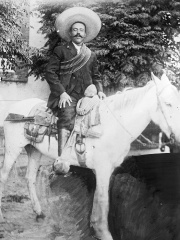
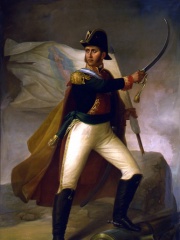
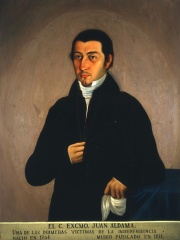
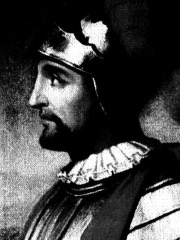
The Most Famous
MILITARY PERSONNELS from Mexico
This page contains a list of the greatest Mexican Military Personnels. The pantheon dataset contains 2,058 Military Personnels, 5 of which were born in Mexico. This makes Mexico the birth place of the 47th most number of Military Personnels behind Indonesia, and Portugal.
Top 5
The following people are considered by Pantheon to be the most legendary Mexican Military Personnels of all time. This list of famous Mexican Military Personnels is sorted by HPI (Historical Popularity Index), a metric that aggregates information on a biography's online popularity.

1. Pancho Villa (1878 - 1923)
With an HPI of 73.45, Pancho Villa is the most famous Mexican Military Personnel. His biography has been translated into 65 different languages on wikipedia.
Francisco "Pancho" Villa (UK: PAN-choh VEE-ə, US: PAHN-choh VEE-(y)ə, Spanish: [ˈpantʃo ˈβiʎa]; born José Doroteo Arango Arámbula; 5 June 1878 – 20 July 1923) was a Mexican revolutionary, guerrilla leader, and politician. He was a key figure in the Mexican Revolution, which forced out President and dictator Porfirio Díaz and brought Francisco I. Madero to power in 1911. When Madero was ousted by a coup led by General Victoriano Huerta in February 1913, Villa joined the anti-Huerta forces in the Constitutionalist Army led by Venustiano Carranza. After the defeat and exile of Huerta in July 1914, Villa broke with Carranza. Villa dominated the meeting of revolutionary generals that excluded Carranza and helped create a coalition government. Emiliano Zapata and Villa became formal allies in this period. Like Zapata, Villa was strongly in favor of land reform, but did not implement it when he had power. Villa served as provisional governor of Chihuahua from 1913 to 1914. At the height of his power and popularity in late 1914 and early 1915, the U.S. considered recognizing Villa as Mexico's legitimate president. In Mexico, Villa is generally regarded as a hero of the Revolution who dared to stand up to the United States. Some American media outlets describe Villa as a villain and a murderer. In November 1915, civil war broke out when Carranza challenged Villa. Villa was decisively defeated by Constitutionalist general Álvaro Obregón in summer 1915, and the U.S. aided Carranza directly against Villa in the Second Battle of Agua Prieta. Much of Villa's army left after his defeat on the battlefield and because of his lack of resources to buy arms and pay soldiers' salaries. Angered at U.S. support for Carranza, Villa conducted a raid on the border town of Columbus, New Mexico, to goad the U.S. into invading Mexico in 1916. Despite a major contingent of soldiers and superior military technology, the U.S. failed to capture Villa. When Carranza was ousted from power in 1920, Villa negotiated an amnesty with interim president Adolfo de la Huerta and was given a landed estate, on the condition he retire from politics. Villa was assassinated in 1923. Although his faction did not prevail in the Revolution, he was one of its most charismatic and prominent figures. In life, Villa helped fashion his own image as an internationally known revolutionary hero, starring as himself in Hollywood films and giving interviews to foreign journalists, most notably John Reed. After his death he was excluded from the pantheon of revolutionary heroes until the Sonoran generals Obregón and Calles, whom he battled during the Revolution, were gone from the political stage. Villa's exclusion from the official narrative of the Revolution might have contributed to his continued posthumous popular acclaim. He was celebrated during the Revolution and long afterward by corridos, films about his life and novels by prominent writers. In 1976, his remains were reburied in the Monument to the Revolution in Mexico City in a huge public ceremony.

2. Ignacio Allende (1769 - 1811)
With an HPI of 59.49, Ignacio Allende is the 2nd most famous Mexican Military Personnel. His biography has been translated into 20 different languages.
Ignacio José de Allende y Unzaga (US: , UK: , Spanish: [iɣˈnasjo aˈʝende]; January 21, 1769 – June 26, 1811), commonly known as Ignacio Allende, was a captain of the Spanish Army in New Spain who came to sympathize with the Mexican independence movement. He attended the secret meetings organized by Josefa Ortiz de Domínguez, where the possibility of an independent Mexico was discussed. He fought along with Miguel Hidalgo y Costilla in the first stage of the struggle, eventually succeeding him in leadership of the rebellion. Allende was captured by Spanish colonial authorities while he was in Coahuila and executed for treason in Chihuahua.

3. Juan Aldama (1774 - 1811)
With an HPI of 55.14, Juan Aldama is the 3rd most famous Mexican Military Personnel. His biography has been translated into 16 different languages.
Juan Aldama (January 3, 1774 in San Miguel el Grande, Guanajuato – June 26, 1811 in Chihuahua) was a Mexican revolutionary rebel soldier during the Mexican War of Independence in 1810.

4. Juan de Salcedo (1549 - 1576)
With an HPI of 53.82, Juan de Salcedo is the 4th most famous Mexican Military Personnel. His biography has been translated into 17 different languages.
Juan de Salcedo (Spanish pronunciation: [ˈxwan de salˈθeðo]; 1549 – 11 March 1576) was a Spanish conquistador. He was the grandson of Spanish general Miguel López de Legazpi. Salcedo was one of the soldiers who accompanied the Spanish conquest to the Philippines in 1565. He joined the Spanish military in 1564 at age 15, on their voyage of exploration to the East Indies and the Pacific, in search of rich resources such as gold and spice, and to find a passage to the islands were the previous Spanish expeditions led by Ferdinand Magellan had landed in 1521, and Ruy López de Villalobos in 1543. In 1567, at age 18, Salcedo the youngest soldier in the Spanish infantry, led an army of about 300 Spanish and Mexican soldiers (Filipino and Spanish historian, Carlos Quirino estimated that over half of the expedition members where Mexicans of various mixed ethnicities, mainly Criollo, Mestizo and Indio, with the remaining being Spaniards from Spain) and 600 Visayan allies along with Martín de Goiti for their conquest of Manila (then under the Islamic occupation by the Sultanate of Brunei). There they fought a number of battles against the natives and their leaders, mainly against the chieftain Rajah Tarik Sulayman (a name derived from Arabic طارق بن زياد "Tāriq"), Islamic settlements in Philippines were abundant before and during the Mexican-Spanish conquest. The Spanish soldiers, together with their native Filipino allies coalesced in 1570 and 1571, to attack the native tribes and the Islamic settlements in the island of Luzon, in order to take control of their lands. American historian William Scott called Salcedo, "the last of the Conquistadores." In May 1572, Salcedo led an exploration expedition of 45 Spaniards northward and founded several Spanish settlements, including the Ilocos and the city of Vigan. Leaving 30 of his men at Vigan, Salcedo proceeded to sail around the northern Luzon coast, and down the eastern shore, with 15 men in 2 open boats. He returned to Manila 3 months later with 50 pounds of gold. Salcedo was granted with estates called haciendas, along with the city of Vigan, for the lands he had conquered by King Philip II of Spain. In 1574, Salcedo hurried back to Manila, when that city was threatened by a large pirate invasion led by Limahong who had sailed from the South China Sea. Salcedo gathered 600 infantry soldiers consisting of 300 Spaniards and Mexicans, plus their allies of 300 native Filipinos to defend the settlements and drive out the 6,500 Chinese sea pirates who had laid siege on the area. Afterwards intense fighting had occurred, and a number of his soldiers had died during the altercation. The Spaniards were able to repel the pirates. Following the Spanish success in the Battle of Manila in 1574, Salcedo pursued Limahong to Pangasinan in 1575. There the Spaniards besieged the pirates for four months, before Limahong surrendered and made good of his escape. After the war, he returned to the Ilocos to govern the settlements. There he would spend his final years. Salcedo died suddenly in March 1576, after a short illness, probably of dysentery at the age of 27.
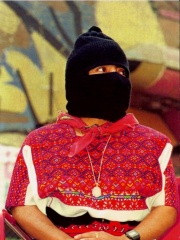
5. Comandanta Ramona (1960 - 2006)
With an HPI of 51.66, Comandanta Ramona is the 5th most famous Mexican Military Personnel. Her biography has been translated into 17 different languages.
Comandanta Ramona (1959–6 January 2006) was an officer of the Zapatista Army of National Liberation (EZLN), a revolutionary indigenous autonomist organization based in the southern Mexican state of Chiapas. She led the Zapatista Army into San Cristóbal de las Casas during the Zapatista uprising of 1994, and was the first Zapatista to appear publicly in Mexico City. She was one of the most important public figures during the first stages of the Zapatista Uprising and was central to the Indigenous Women's Movement.
People
Pantheon has 5 people classified as Mexican military personnels born between 1549 and 1960. Of these 5, none of them are still alive today. The most famous deceased Mexican military personnels include Pancho Villa, Ignacio Allende, and Juan Aldama.
Deceased Mexican Military Personnels
Go to all RankingsPancho Villa
1878 - 1923
HPI: 73.45
Ignacio Allende
1769 - 1811
HPI: 59.49
Juan Aldama
1774 - 1811
HPI: 55.14
Juan de Salcedo
1549 - 1576
HPI: 53.82
Comandanta Ramona
1960 - 2006
HPI: 51.66
Overlapping Lives
Which Military Personnels were alive at the same time? This visualization shows the lifespans of the 4 most globally memorable Military Personnels since 1700.

